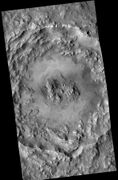Auki (crater)
Topic: Astronomy
 From HandWiki - Reading time: 6 min
From HandWiki - Reading time: 6 min
Auki is an impact crater in the Mare Tyrrhenum quadrangle of Mars, at 15.76 °S latitude and 263.13 °W longitude. It is 40.0 km in diameter and was named after Auki, a town in the Solomon Islands, in 2015 by the International Astronomical Union (IAU) Working Group for Planetary System Nomenclature (WGPSN).[1]
Auki Crater has a central peak. Impact craters generally have a rim with ejecta around them, in contrast volcanic craters usually do not have a rim or ejecta deposits. As craters get larger (greater than 10 km in diameter) they usually have a central peak.[2] The peak is caused by a rebound of the crater floor following the impact.[3]
Strong evidence for hydrothermalism was reported by a team of researchers studying Auki. This crater contains ridges that may have been produced after fractures formed with an impact. Using instruments on the Mars Reconnaissance Orbiter they found the minerals smectite, silica, zeolite, serpentine, carbonate, and chlorite that are common in impact-induced hydrothermal systems on Earth.[4][5][6][7][8][9] Other evidence of post-impact hydrothermal systems on Mars from other scientists who studied other Martian craters.[10][11][12]
Impacts fracture rocks and create a great deal of heat that may last for many thousands of years. [13] This heat can result in new minerals from hydrothermal circulation. On Earth impact craters have resulted in useful minerals. Some of the ores produced from impact related effects on Earth include ores of iron, uranium, gold, copper, and nickel. It is estimated that the value of materials mined from impact structures is 5 billion dollars/year just for North America.[14] While nothing may be found on Mars that would justify the high cost of transport to Earth, the more necessary ores future colonists can obtain from Mars, the easier it would be to build colonies on the Red Planet.[15]
See also
References
- ↑ "Auki (crater)". Gazetteer of Planetary Nomenclature. USGS Astrogeology Research Program.
- ↑ "Stones, Wind, and Ice: A Guide to Martian Impact Craters". http://www.lpi.usra.edu/publications/slidesets/stones/.
- ↑ Hugh H. Kieffer (1992). Mars. University of Arizona Press. ISBN 978-0-8165-1257-7. https://books.google.com/books?id=NoDvAAAAMAAJ. Retrieved 7 March 2011.
- ↑ Carrozzo, F. et al. 2017. Geology and mineralogy of the Auki Crater, Tyrrhena Terra, Mars: A possible post impact-induced hydrothermal system. 281: 228-239
- ↑ Loizeau, D. et al. 2012. Characterization of hydrated silicate-bearing outcrops in tyrrhena Terra, Mars: implications to the alteration history of Mars. Icarus: 219, 476-497.
- ↑ Naumov, M. 2005. Principal features of impact-generated hydrothermal circulation systems: mineralogical and geochemical evidence. Geofluids: 5, 165-184.
- ↑ Ehlmann, B., et al. 2011. Evidence for low-grade metamorphism, hydrothermal alteration, and diagenesis on Mars from phyllosilicate mineral assemblages. Clays Clay Miner: 59, 359-377.
- ↑ Osinski, G. et al. 2013. Impact-generated hydrothermal systems on Earth and Mars. Icarus: 224, 347-363.
- ↑ Schwenzer, S., D. Kring. 2013. Alteration minerals in impact-generated hydrothermal systems – Exploring host rock variability. Icarus: 226, 487-496.
- ↑ Marzo, G., et al. 2010 Evidence for hesperian impact-induced hydrothermalism on Mars. Icarus: 667-683.
- ↑ Mangold, N., et al. 2012 Hydrothermal alteration in a late hesperian impact crater on Mars. 43rd Lunar and Planetary Science. #1209.
- ↑ Tornabene, L., et al. 2009. Parautochthonous megabreccias and possible evidence of impact-induced hydrothermal alteration in holden crater, Mars. 40th LPSC. #1766.
- ↑ Dohm, J.; Hare, T.; Robbins, S.; Williams, J.-P.; Soare, R.; El-Maarry, M.; Conway, S.; Buczkowski, D.; Kargel, J.; Banks, M.; Fairén, A.; Schulze-Makuch, D.; Komatsu, G.; Miyamoto, H.; Anderson, R.; Davila, A.; Mahaney, W.; Fink, W.; Cleaves, H.; Yan, J.; Hynek, B.; Maruyama, S. (2015). "Geological and hydrological histories of the Argyre province, Mars". Icarus. 253: 66–98. Bibcode:2015Icar..253...66D. doi:10.1016/j.icarus.2015.02.017.
- ↑ Grieve, R., V. Masaitis. 1994. The Economic Potential of Terrestrial Impact Craters. International Geology Review: 36, 105-151.
- ↑ Larry O'Hanlon (February 22, 2010). "Mining Mars? Where's the Ore?". Discovery News. http://news.discovery.com/space/mars-prospecting-ores-gold.html.
Recommended reading
- Lorenz, R. 2014. The Dune Whisperers. The Planetary Report: 34, 1, 8-14
 |
 KSF
KSF




